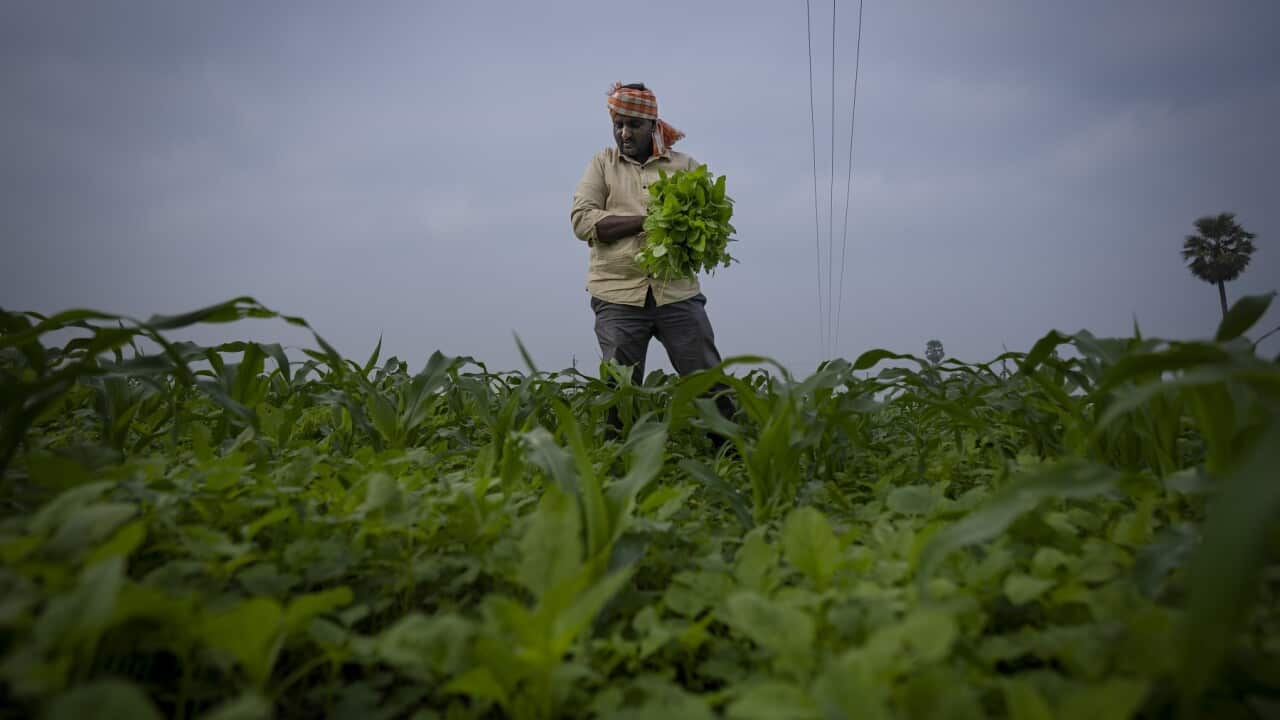English
When Cyclone Michaung struck India last year, it brought wind up to 110 kilometres per hour and heavy rainfall across the country's south-eastern coast, flooding towns and fields.
A preliminary damage assessment found 600,000 acres of crops were destroyed in Andhra Pradesh state alone.
But not every farm suffered the same fate.
Some fields were still full of strong, healthy plants.
Why? Some say it was the farming practices used.
More farmers are now starting to embrace natural farming as they see how it can help when extreme weather hits.
Ratna Raju is one who has signed up to the idea.
There's a pungent odour on his farm in Guntur in India's southern Andhra Pradesh state.
The smell comes from a concoction of cow urine, an unrefined sugar known as jaggery and other organic materials that act as fertilisers, pesticides and bad weather barriers for his crops.
“Last December 4th, a cyclone hit us. All the surrounding crops fell. But our five and half acre farm stood strong. We have been practising natural farming here for the past four years. Because of natural farming, the root system is deep and strong. It can withstand the impacts of cyclones. Within a few days, our soil absorbed all the water. In neighbouring farms, water stood for seven to 10 days.”
Andhra Pradesh has become a positive example of the benefits of natural farming, and advocates say active government support is the primary driver for the state’s success.
Raja Kumari is district program manager for Andhra Pradesh Community Managed Natural Farming.
“Improving soil health is the key to natural farming. Soil health is key in natural farming, and we achieve it with diversity of crops. With diversity of crops, we give the soil also more microbes, diversity in microbes. So it will (give) more nutrients to the soil."
Experts say these methods should be expanded across India's vast agricultural lands as climate change and decreasing profits have led to multiple farmers' protests this year.
But government support for these alternative methods remains limited.
As a result, most farmers continue to rely on chemical pesticides and fertilisers.
While effective in the short term, these chemical alternatives degrade soil health over time, and lead to higher costs and poorer soil quality.
According to Nas Suresh, a research scientist at the Center for Study of Science, Technology and Policy, local and federal government initiatives have already encouraged approximately 750,000 farmers in the state to embrace natural farming.
“So Andhra Pradesh has witnessed a transformative shift towards natural farming. Currently there are about 7 lakh 50,000 (750,000) farmers following the natural farming practice. The success to achieve this number of farmers is mainly due to the establishment of a dedicated institute named Rythu Sadhikara Samstha by the government of Andhra Pradesh. ... We have also done a survey in Andhra Pradesh in 2018 and we have witnessed that the natural farming crops had shown much higher climate resilience during the flood-prone conditions whereas the conventional chemical-based crops had resulted in degradation.”
Andhra Pradesh is on a mission to get its six million farmers into natural farming by 2030.
The Indian government's already poured over $8 million into the push, with almost a million acres nationwide making the switch.
Last March, the junior agriculture minister set a goal for 25 per cent of Indian farms to embrace organic and natural methods.
But early adopters like Meerabi Chunduru argue they need more support from both government and politicians.
“Many farmers have changed to natural farming. They are noticing the climate changes and seeing the losses suffered by conventional farmers. If more farmers take up natural farming as it used to be in our childhood we can have similar healthy food, soil and stable climate as it was in the past. We can leave behind healthy food, soil and Earth for the next generations."
As the practice helps keep the plants and the soil healthy across various soil types and all kinds of unpredictable weather conditions, it's beneficial for farmers all around India, from its mountains to its coasts, experts say.
And the practice of planting different crops year-round means farmers can produce to harvest at any given time, giving an extra boost to their soil and their wallets.
Inglese
Quando il ciclone Michaung si è abbattuto sull'India lo scorso anno, ha portato vento fino a 110 chilometri orari e forti piogge sulla costa sud-orientale del Paese, inondando città e campi.
Secondo una prima valutazione dei danni, solo nello Stato di Andhra Pradesh sono andati distrutti 600.000 acri di colture.
Ma non tutte le aziende agricole hanno subito la stessa sorte.
Alcuni campi erano ancora pieni di piante forti e sane.
Perché? Alcuni sostengono che sia dovuto alle pratiche agricole utilizzate.
Un numero sempre maggiore di agricoltori sta iniziando ad adottare l'agricoltura naturale, perché vede che può essere d'aiuto quando si verificano eventi meteorologici estremi.
Ratna Raju è uno di quelli che ha aderito all'idea.
Nella sua fattoria di Guntur, nello Stato meridionale dell'Andhra Pradesh, c'è un odore pungente.
L'odore proviene da un miscuglio di urina di mucca, uno zucchero non raffinato noto come jaggery e altri materiali organici che fungono da fertilizzanti, pesticidi e barriere contro il maltempo per le sue colture.
“Last December 4th, a cyclone hit us. All the surrounding crops fell. But our five and half acre farm stood strong. We have been practising natural farming here for the past four years. Because of natural farming, the root system is deep and strong. It can withstand the impacts of cyclones. Within a few days, our soil absorbed all the water. In neighbouring farms, water stood for seven to 10 days.”
L'Andhra Pradesh è diventato un esempio positivo dei benefici dell'agricoltura naturale e i sostenitori affermano che il sostegno attivo del governo è il motore principale del successo dello Stato.
Raja Kumari è responsabile del programma distrettuale per l'Andhra Pradesh Community Managed Natural Farming.
“Improving soil health is the key to natural farming. Soil health is key in natural farming, and we achieve it with diversity of crops. With diversity of crops, we give the soil also more microbes, diversity in microbes. So it will (give) more nutrients to the soil."
Secondo gli esperti, questi metodi dovrebbero essere estesi a tutte le vaste terre agricole indiane, dato che il cambiamento climatico e la diminuzione dei profitti hanno portato a numerose proteste degli agricoltori quest'anno.
Ma il sostegno del governo a questi metodi alternativi rimane limitato.
Di conseguenza, la maggior parte degli agricoltori continua a fare affidamento su pesticidi e fertilizzanti chimici.
Sebbene efficaci nel breve periodo, queste alternative chimiche degradano la salute del suolo nel tempo, comportando costi più elevati e una qualità del suolo più scadente.
Secondo Nas Suresh, ricercatore del Center for Study of Science, Technology and Policy, le iniziative del governo locale e federale hanno già incoraggiato circa 750.000 agricoltori dello Stato ad adottare l'agricoltura naturale.
“So Andhra Pradesh has witnessed a transformative shift towards natural farming. Currently there are about 7 lakh 50,000 (750,000) farmers following the natural farming practice. The success to achieve this number of farmers is mainly due to the establishment of a dedicated institute named Rythu Sadhikara Samstha by the government of Andhra Pradesh. ... We have also done a survey in Andhra Pradesh in 2018 and we have witnessed that the natural farming crops had shown much higher climate resilience during the flood-prone conditions whereas the conventional chemical-based crops had resulted in degradation.”
L'Andhra Pradesh ha l’obiettivo di portare i suoi sei milioni di agricoltori all'agricoltura naturale entro il 2030.
Il governo indiano ha già investito oltre 8 milioni di dollari in questa iniziativa, con quasi un milione di ettari di terreno a livello nazionale.
Lo scorso marzo, il Ministro dell'Agricoltura ha fissato l'obiettivo che il 25% delle aziende agricole indiane adottino metodi biologici e naturali.
Ma i primi ad adottare metodi biologici, come Meerabi Chunduru, sostengono di aver bisogno di un maggiore sostegno da parte del governo e dei politici.
“Many farmers have changed to natural farming. They are noticing the climate changes and seeing the losses suffered by conventional farmers. If more farmers take up natural farming as it used to be in our childhood we can have similar healthy food, soil and stable climate as it was in the past. We can leave behind healthy food, soil and Earth for the next generations."
Poiché questa pratica aiuta a mantenere in salute le piante e il terreno in vari tipi di suolo e in tutte le condizioni climatiche imprevedibili, è vantaggiosa per gli agricoltori di tutta l'India, dalle montagne alle coste, dicono gli esperti.
Inoltre, la pratica di piantare colture diverse tutto l'anno significa che gli agricoltori possono produrre per raccogliere in qualsiasi momento, dando un ulteriore impulso al loro terreno e al loro portafoglio.




